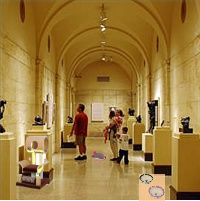Kinigsburg, E.L. (1967). From the Mixed-Up Files of Mrs. Basil E. Frankweiler. New York: Aladdin Paperbacks.
162 pages.
As a child, I always meant to read The Mixed-Up Files. I just never got around to it. The same was true when I was an adult.
It took my students choosing it as a class read to finally getting around to reading it.
And as I started the book, I wished I'd gotten around to it much sooner. From the first page I as entertained by Claudia's characterization.
Appetizer: Claudia Kincaid, the oldest of four children, has decided to run away. But the detail-oriented girl refuses to do it in the ordinary way. She plots and plans, saves money and chooses one of her little brothers--who compliments her well--to join her in escaping to the Metropolitan Museum of Art.
Her and Jamie work as a team to mange how to get food, find a place to sleep and do laundry.
When a new exhibit of a small angel statue is put on display, Claudia can't help but be drawn in by the mystery of the sculpture and wants her and Jamie to to solve the mystery of whether or not Michelangelo sculpted it.
I like how practical the book is. Konigsburg makes a point of dealing with all of the issues about how the Claudia and Jamie spent their money (got more money), remained hidden from the museum security and spent their time.
(Of course, including these practical issues also dates the text since the value of a dollar has inflated so much. It's hard to imagine a train ticket, a meal, etc. ever being as cheap as they are in the book. Plus, the siblings don't have to contend with any high-tech security systems that a runaway of today might face...not that I've given this thought and am considering running away to a museum. Not at all.)
Hello, Columbus Museum of Art....
You are a nice museum, aren't you?
No. No plans to run away to the museum. None at all.
I mean, who would feed my cats while I was gone?
While the four students who chose to read the book (alas, this is the problem between having students pick between reading a novel and a picturebook, almost all of them chose the picturebook) enjoyed it, as a group we failed to address one of the biggest potential problems of the text. The fact that the main characters run away and the messages that sends (while Claudia and Jamie do feel a little homesick, the reader is almost entirely denied seeing the grief that their family experienced at their disappearance).
The easiest argument is to say that the book provides the reader with a sense of escape and that no reader will actually be inspired to run away based on reading the book. And I don't really have any thoughts to add to that argument since there aren't any statistics on children who were inspired by 1960s children's literature to leave home and camp-out at a national museum.
Dinner Conversation:
"You never knew that I could write this well, did you? Of course, you don't actually know yet, but you soon will. I've spent a lot of time on this file. I listened. I investigated, and I fitted all the pieces together like a jigsaw puzzle. It leaves no doubts. Well, Saxonberg, read and discover" (p. 3).
"Claudia knew that she could never pull off the old-fashioned kind of running away. That is, running away in the heat of anger with a knapsack on her back. She didn't like discomfort; even picnics were untidy and inconvenient: all those insect and the sun melting the icing on the cupcakes. Therefore, she decided that her leaving home would not be just running from somewhere but would be running to somewhere. To a large place, a comfortable place. And that's why she decided upon the Metropolitan Museum of Art in New York City" (p. 5).
"I want you, Jamie, for the greatest adventure in our lives."
Jamie muttered, "Well, I wouldn't mind if you'd pick on someone else."
"Claudia looked out the window and didn't answer. Jamie said, "As long as you've got me here, tell me" (p. 13).
"This was all Claudia needed. Something that had been smoldering inside her since she first saw the statue, that had been fed by the Times article, now flared into an idea.
"Jamie, let's do it now. Let's skip learning everything about everything in the museum. Let's concentrate on the statue" (p. 62)
Tasty Rating: !!!





Your students have fine taste; this is such a good book.
ReplyDeleteIt definitely does date itself, which is part of why I think I liked it so much as a kid (and like it now). Spending ten cents on breakfast seems so quaint and otherworldly.
Aw, I did love that book. Weirdly, living in a museum is more appealing to me now than when I was a kid.
ReplyDelete